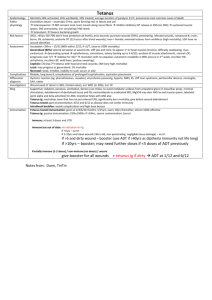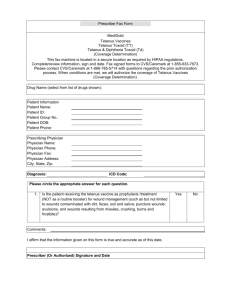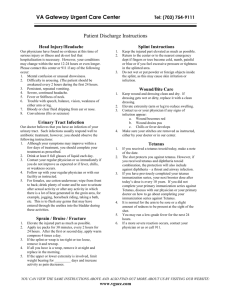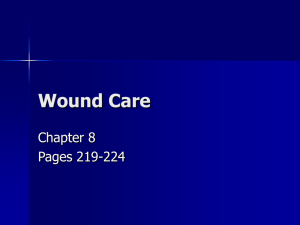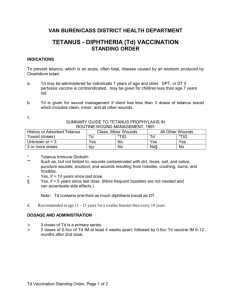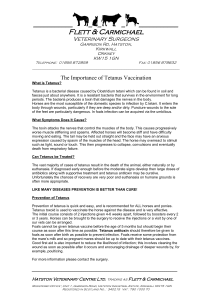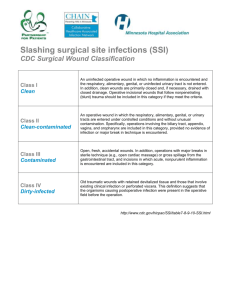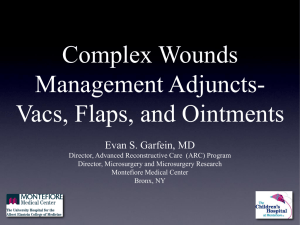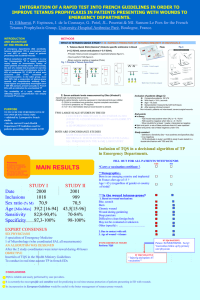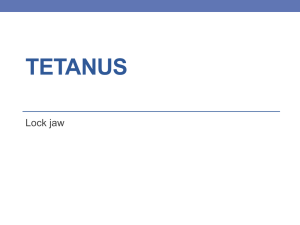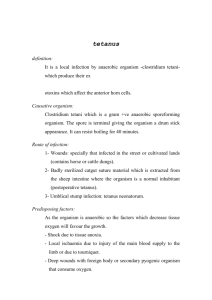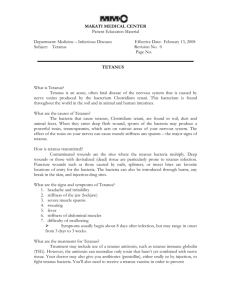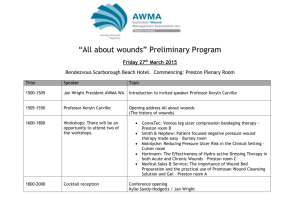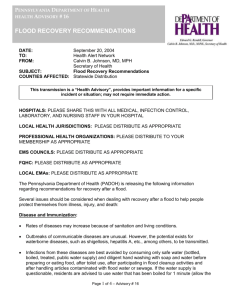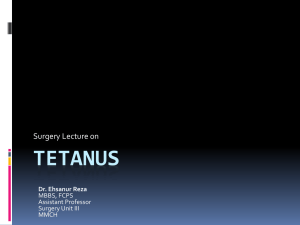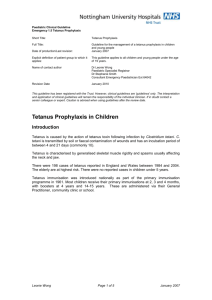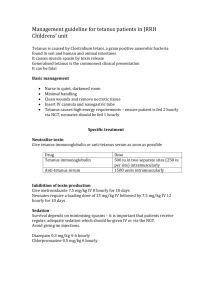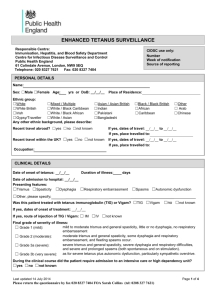Tetanus - WordPress.com
advertisement
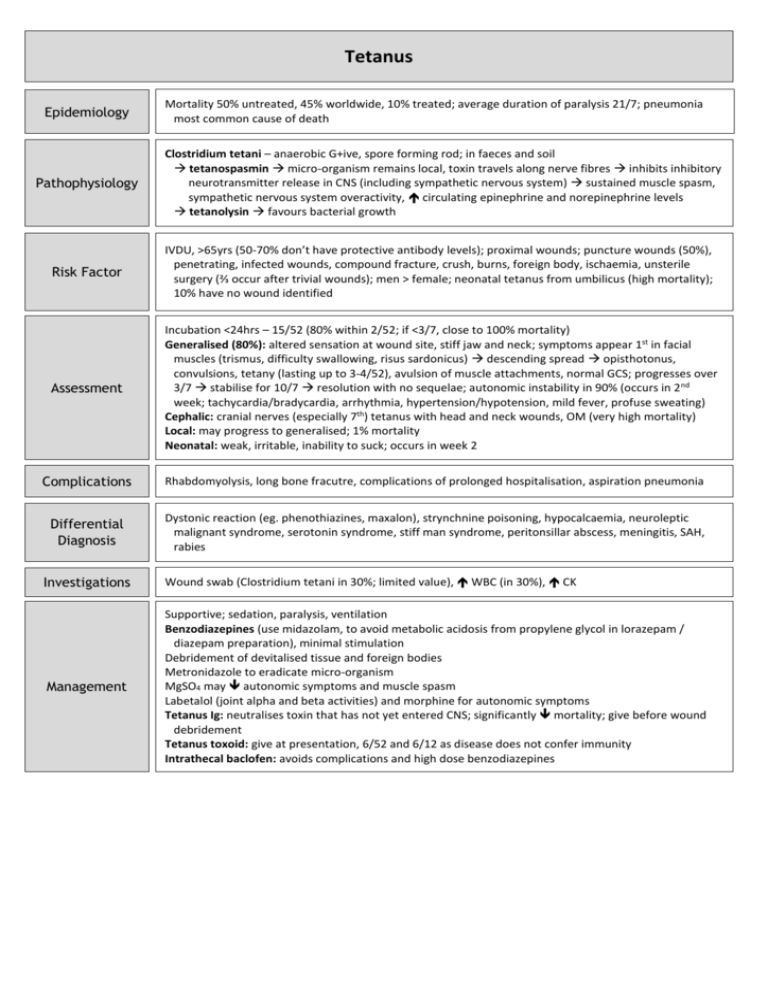
Tetanus Epidemiology Pathophysiology Mortality 50% untreated, 45% worldwide, 10% treated; average duration of paralysis 21/7; pneumonia most common cause of death Clostridium tetani – anaerobic G+ive, spore forming rod; in faeces and soil tetanospasmin micro-organism remains local, toxin travels along nerve fibres inhibits inhibitory neurotransmitter release in CNS (including sympathetic nervous system) sustained muscle spasm, sympathetic nervous system overactivity, circulating epinephrine and norepinephrine levels tetanolysin favours bacterial growth Risk Factor IVDU, >65yrs (50-70% don’t have protective antibody levels); proximal wounds; puncture wounds (50%), penetrating, infected wounds, compound fracture, crush, burns, foreign body, ischaemia, unsterile surgery (⅔ occur after trivial wounds); men > female; neonatal tetanus from umbilicus (high mortality); 10% have no wound identified Assessment Incubation <24hrs – 15/52 (80% within 2/52; if <3/7, close to 100% mortality) Generalised (80%): altered sensation at wound site, stiff jaw and neck; symptoms appear 1st in facial muscles (trismus, difficulty swallowing, risus sardonicus) descending spread opisthotonus, convulsions, tetany (lasting up to 3-4/52), avulsion of muscle attachments, normal GCS; progresses over 3/7 stabilise for 10/7 resolution with no sequelae; autonomic instability in 90% (occurs in 2 nd week; tachycardia/bradycardia, arrhythmia, hypertension/hypotension, mild fever, profuse sweating) Cephalic: cranial nerves (especially 7th) tetanus with head and neck wounds, OM (very high mortality) Local: may progress to generalised; 1% mortality Neonatal: weak, irritable, inability to suck; occurs in week 2 Complications Rhabdomyolysis, long bone fracutre, complications of prolonged hospitalisation, aspiration pneumonia Differential Diagnosis Dystonic reaction (eg. phenothiazines, maxalon), strynchnine poisoning, hypocalcaemia, neuroleptic malignant syndrome, serotonin syndrome, stiff man syndrome, peritonsillar abscess, meningitis, SAH, rabies Investigations Wound swab (Clostridium tetani in 30%; limited value), WBC (in 30%), CK Management Supportive; sedation, paralysis, ventilation Benzodiazepines (use midazolam, to avoid metabolic acidosis from propylene glycol in lorazepam / diazepam preparation), minimal stimulation Debridement of devitalised tissue and foreign bodies Metronidazole to eradicate micro-organism MgSO4 may autonomic symptoms and muscle spasm Labetalol (joint alpha and beta activities) and morphine for autonomic symptoms Tetanus Ig: neutralises toxin that has not yet entered CNS; significantly mortality; give before wound debridement Tetanus toxoid: give at presentation, 6/52 and 6/12 as disease does not confer immunity Intrathecal baclofen: avoids complications and high dose benzodiazepines Normal Immunisation Tetanus Ig Immune Given at 2 / 4 / 6 / 18 months, 5 / 15yrs, every 10yrs thereafter; almost 100% effective Passive immunisation; 250iu (500iu if >24hrs, severe contamination, burns) If a patient has had at least 3 doses and is UTD No indication for Ig ever Immunisation Immunised but out of date Partially immune (1-2 doses) or nonimmune or unsure If <5yrs: no treatment needed If 5-10yrs and clean wound (<6hrs old, non-penetrating, negligible tissue damage): no treatment needed If >5yrs and dirty wound: give booster (use ADT if >40yrs as diptheria immunity not life long) If >10yrs: booster; may need further doses if <5 doses of ADT previously Give booster for all wounds + tetanus Ig if dirty ADT at 1/12 and 6/12
